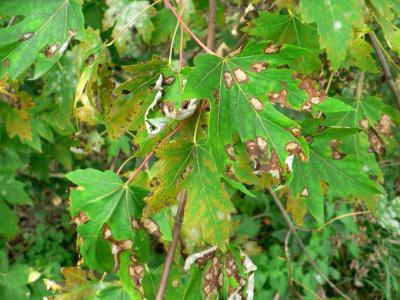Delicious amber grapes, which have absorbed a maximum of solar heat and rays, are a favorite treat of every person. Large clusters hanging in the dense greenery of the bushes delight in their size and shape. To grow such beauty, it takes a lot of work and spend a lot of time. In addition, there is always a risk of damage to bushes by pests and diseases, one of which, although quite rare, is the anthracnose of grapes.
The photo fully conveys how dangerous this disease is for the plant.
Dangerous grape disease: anthracnose
Anthracnose of grapes is a fungal disease, the development of which is more likely to occur on the green aboveground parts of the plant: leaves, shoots, inflorescences and berries (before their ripening). The causative agent of the disease is the fungus Gloeosporium ampelinum. Sass, forming at the initial stage a colorless mycelium, turning brown over time. Under the cuticle on the mycelium, the formation of short cylindrical conidiophores with colorless single conidia occurs. Formed throughout the growing season and growing, they break the cuticle, as a result of which the conidia come out.
The incubation period at an optimum temperature for the development of the fungus - 23 -32
is 3-4 days. Most of all, anthracnose affects vineyards growing in areas of humid climate and elevated temperature. The disease is especially severe in wet, rainy weather and can cause damage to the plant at the very beginning of the growing season.
Signs of Anthracnose
The appearance of anthracnose can be determined by the leaves that the disease affects in the first place. They form spots of light gray in color, the edges of which are surrounded by an uneven dark brown or reddish rim. Appearing in the form of small dots and dots, during the development of the disease they increase, acquiring an angularity. This leads to the destruction of leaf tissue in the affected areas and the loss of such areas, causing the formation of holes.
Anthracnose grapes along with leaf damage covers the shoots, appearing on them with brownish small spots with uneven edges. As the bush grows, they are extended and pressed, acquiring a coffee shade with dark purple edges. Such ulcers on the plant, often merging into a single spot, ring the shoot, can be very deep, capture the wood part in addition to the bark, than disrupt the flow of nutrients. Heavily affected parts of the grape bush become charred, black, easily breaking. The leaves on them are small, often dried. How to treat grape anthracnose? A photo of damaged shoots shows what danger this fungal disease poses to a grape bush. Obviously, you can’t let everything go by itself.

The anthracnose of grapes is especially dangerous for young ridges, infecting them during the flowering period or earlier. As a result, the inflorescences dry out and die off (partially or fully). Berries are also affected by anthracnose. Deformed, with dented spots and uneven growth on clusters, they present a very sad sight, often tearing and exposing seeds at the lesion sites.
Anthracnose resistant varieties
A strong development of the disease leads to browning and complete drying of the entire aerial part of the plant, and, as a result, to its death. Anthracnose of grapes can spread through raindrops, irrigation water, insects, and even work equipment. Most often, the disease proceeds focal and to a greater extent affects such varieties as Lydia, Husain, Karaburnu, Isabella. Anthracnose resistant are Tzolikouri, Riesling, Nimrang, Saperavi, Sauvignon.
The introduction of anthracnose resistant grape varieties will be the most effective measure against this disease. But if the disease still hit the plant, how to treat grape anthracnose?
The fungus is able to overwinter on the remains of the vine and wake up with the plant in the spring. Therefore, protective measures aimed at preventing and combating the disease include mandatory cutting and destruction of affected shoots.
Preparations for Anthracnose Grapes
As a preventive measure, throughout the entire growing season, it is required to spray with drugs such as Ridomil, Horus, Bordeaux Liquid, which should be used within a few hours after preparation.
Processing is recommended to be done in calm weather in the morning or in the evening, without allowing fungicides to get on nearby crops. Such preparations are not washed off by rain, quickly penetrate into the
tissues of plants and begin to act 2-3 hours after spraying.
Anthracnose control
Microbiological preparations proved to be excellent in the fight against anthrocnosis: “Haupsin”, “Planriz”, “Mikosan”, which in addition to the protective effect have powerful growth-promoting properties. The drugs are not toxic to humans and animals and do not affect the taste of the grown product. Effectiveness in the fight against anthracnose is up to 94%. Also, in the fight against fungal disease, it is recommended to use preparations containing copper, such as Poliram, Copper oxychloride, Abiga-Peak, and Kartotsid. Their use is made upon reaching vegetative shoots of 10-15 centimeter length.